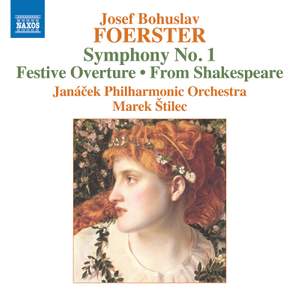
Josef Bohuslav Foerster (1859-1951)
Festive Overture, Op 70 (1907)
Symphony No 1 in D minor, Op 9 (1887/88)
From Shakespeare, Op 76 (1908-10)
Janáček Philharmonic Orchestra/Marek Štilec
rec. 2021, House of Culture, Ostrava, Czech Republic
NAXOS 8.574336 [64]
Foerster was in the generation of Czech composers that followed in the wake of Dvořák, and consequently found it difficult to maintain a presence, much in the way that Finnish composers after Sibelius got lost in his shadow. Foerster literally followed in Dvořák’s footsteps, as his successor in the role of organist at St Vojtěch Church in Prague. Foerster was born into a musical family; his father taught at the Prague Conservatory, numbering Franz Lehár among his students. Foerster fil worked as critic, teacher and composer around central Europe, including Hamburg where he and Mahler became friends. Early in his long career as composer – there are almost 200 opus numbers in his output, the last being only a few years before his death at 91 – he received help from Smetana, Grieg and Tchaikovsky.
His music, be it early like the First Symphony, or mid-career as in the other two works here, is not nationalist in the sense of using Czech folk music. Its soundworld is more Austro-Germanic, Brahms and Schumann as reference points, especially in the first two works. The Festival Overture, written to celebrate the opening of a theatre in a town near Prague, is suitably celebratory, and would be enjoyed by any modern audience as a concert opener. Sadly, the chances of that happening any time soon seem unlikely.
The First Symphony, written in the shadow of his mother’s death has the common Romantic trajectory of darkness to light. The thematic material isn’t “stick-in-the-mind” memorable, but it is enjoyable, as is the orchestral colouring. The writing for the brass is very effective, and I certainly would rate this as being at the same level as the Second and Fourth Schumann symphonies, having heard that cycle performed by our city orchestra this year.
The tone poem From Shakespeare paints pictures of characters from four of the Bard’s plays: Perdita (The Winter’s Tale), Viola (Twelfth Night), Lady Macbeth and Katharina and Petruchio (The Taming of the Shrew). It shows a significant advance, or at least change, in style, showing an undoubted influence of his friend, but it is more the nostalgic and nature-loving, rather than the angst-ridden Mahler that comes through. The best is probably the Lady Macbeth movement, which begins in a rhapsodic manner, but does build up to a dramatic climax midway through, after which it becomes more sombre. The Mahler influence is very easy to pick up here.
With this release, Naxos adds to its Foerster catalogue after a long break. The Fourth Symphony was released in 2006 (review ~ review), with the Slovak Radio Symphony, a regular with Naxos back then. It is something of a surprise to find that one of the discmates of the Fourth Symphony was the Festive Overture that also appears here. There is no indication that this new recording is the start, or indeed continuation, of a Foerster series.
The Janáček Philharmonic Orchestra is a fairly recent addition to the label’s stable, and its recordings, including Shostakovich, Auber and Suppé, have been generally well received. I have encountered Marek Štilec before, working with a Czech chamber orchestra in a recording of Wranitzky, and that was a positive experience. The combination of orchestra and conductor here is a success. There is no doubt that their Festive Overture is more vibrant that the Naxos competitor, though the durations are almost identical, and the sound quality in the newer recording is significantly better. There is only one other competitor for the symphony, from the Osnabruck Symphony on the MDG label, which I haven’t heard. It was released about ten years ago, and in a piece of timing that Naxos must have been cursing, MDG reissued its full cycle of the five Foerster symphonies in a bargain boxset, one month before the Naxos disc.
All three works have plenty of merit for those wanting something new from the lighter, less angst-ridden end of the Romantic era spectrum. With the usual informative, if not extensive, notes typical of the label, and the very good sound mentioned above, it is certainly worth a punt (though if you’ve just bought the MDG set, you may think differently).
David Barker
Help us financially by purchasing from





















